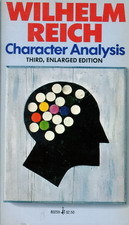
Character Analysis
Third, Enlarged Edition
Reich, Wilhelm
Publisher: Pocket Books, New York, USA
Year First Published: 1933
Year Published: 1976
Pages: 604pp ISBN: 671-80259-3
Resource Type: Book
Cx Number: CX7347
Reich's psychoanalytic investigations of the human character.
Abstract:
-
Table of Contents
Preface to the Third Edition
Preface to the Second Edition
Preface to the First Edition
Part One: Technique
1. Some Problems of Psychoanalytic Technique
2. The Economic Viewpoint in the Theory of Analytic Therapy
3. On the Technique of Interpretation and of Resistance Analysis
1. Some typical errors in the technique of interpretation and other consequences
2. Systematic interpretation and resistance analysis
3. Consistency in resistance analysis
4. On the Technique of Character Analysis
1. Introduction
2. Character armoring and character resistance
a) The inability to follow the basic rule
b) Where do the character resistances come from?
c) On the technique of analyzing the character resistance
d) The technique of dealing with individual situations as derived from the structure of the character resistance
e) The breaking down of the narcissistic defense apparatus
f) On the optimal conditions for the analytic reduction to the infantile situation from the contemporary situation
g) Character analysis in the case of abundantly flowing material
3. A case of passive-feminine character
a) Anamnesis
b) The development and analysis of the character resistance
c) Linking the analysis of the contemporary material to the infantile
4. Summary
5. Indications and Dangers of Character Analysis
6. On the Handling of the Transference
1. The distillation of the genital-object libido
2. Secondary narcissism, negative transference, and insight into illness
3. On the handling of the abstinence rule
4. On the question of the "dissolution" of the positive transference
5. A few remarks about counter-transference
Part Two: Theory of Character Formation
7. The Characterological Resolution of the Infantile Sexual Conflict
1. Content and form of psychic reactions
2. The function of character formation
3. Conditions of character differentiation
8. The Genital Character and the Neurotic Character (The Sex-Economic Function of the Character Armor)
1. Character and sexual stasis
2. The libido-economic difference between the genital character and the neurotic character
a) Structure of the id
b) Structure of the superego
c) Structure of the ego
3. Sublimation, reaction formation, and neurotic reaction basis
9. Childhood Phobia and Character Formation
1. An "aristocratic" character
2. Overcoming of childhood phobia by the formation of character attitudes
10. Some Circumscribed Character Forms
1. The hysterical character
2. The compulsive character
3. The phallic-narcissistic character
11. The Masochistic Character
1. Summary of views
2. The armoring of the masochistic character
3. Inhibited exhibitionism and the passion for self-deprecation
4. Unpleasurable perception of the increase of sexual excitation: the specific basis of the masochistic character
5. Observations on the therapy of masochism
12. Some Observations on the Basic Conflict Between Need and Outer World
Part Three: From Psychoanalysis to Orgone Biophysics
13. Psychic Contact and Vegetative Current
Preface
1. More about the conflict between instinct and outer world
2. Some technical presuppositions
3. The change of function of the impulse
4. The intellect as defense function
5. The interlacing of the instinctual defenses
6. Contactlessness
7. Substitute Contact
8. The psychic representation of the organic
a) The idea of "bursting"
b) On the idea of death
9. Pleasure, anxiety, anger, and muscular armor
10. The two great leaps in evolution
14. The Expressive Language of the Living
1. The function of emotion in orgone therapy
2. Plasmatic expressive movement and emotional expression
3. The segmental arrangement of the armor
4. The emotional expression of the orgasm reflex and sexual superimposition
15. The Schizophrenic Split
1. The "devil" in the schizophrenic process
2. The "forces"
3. The remote schizophrenic expression in the eyes
4. The breakthrough of the depersonalization and first understanding of the schizophrenic split
5. The interdependence of consciousness and self-perception
6. The rational function of the "devilish evil"
7. The Anorgonotic regions in the catatonic state
8. The function of self-damage in schizophrenia
9. Crisis and recovery
16. The Emotional Plague
Index
Subject Headings


